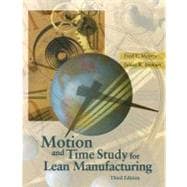
Fred E. Meyers is president of Fred Meyers and Associates, an industrial engineering management consulting company. He designs and implements production improvement and motivation systems. Mr. Meyers is a registered professional industrial engineer and a senior member of the Institute of Industrial Engineers. He has 35 years of industrial engineering experience. He has worked for Caterpillar Tractor Co., Boeing's aerospace division, Mattelloy Co., Times Mirror Corp., Ingersoll-Rand's proto tool division, Spaulding's golf club division, and Southern Illinois University-Carbondale, College of Engineering, where he taught for 20 years while starting and operating his consulting business. He was director of applied research and an associate professor.
Mr. Meyers has worked for over 100 companies as a consultant responsible for installing incentive systems, performance control systems, plant layouts, new product startup, and cost estimating systems. He has worked in heavy equipment manufacturing, aerospace, consumer products, appliance manufacturing, lumber, plywood, paper, oil blending and packaging, furniture, tooling, fiberglass, and many other areas. The variety of his assignments has given him the ability to see the wide-ranging uses of motion and time study.
Fred E. Meyers has taught motion and time study to over 130 classes and 5,000 people, including professional engineers and managers, union stewards, and college students. He has presented seminars to the National Association of Industrial Technology, industrial plants, the U.S. Air Force and Navy, and labor unions.
James R. Stewart is Associate Professor of Technology at Northern Illinois University. For the past decade, he has taught plant layout, engineering economy, manufacturing philosophy, production and inventory systems, industrial quality control, ergonomics, and work measurement and improvement. He is a Fellow in the World Academy of Productivity Science. He is a senior member of the Institute of Industrial Engineers and is a founding member and is on the board of directors of the Society for Work Science. He is also on the board of The International MODAPTS Association. He is an active member of a number of other societies, including NAIT, ASQ, and Human Factors and Ergonomics Society. He has 30 years of experience in work measurement in education, government, and industry.
Dr. Stewart has served on the faculty of several universities; worked in city, county and state productivity programs; and has managed engineering programs in electronics assembly, electronics component fabrication, pulp and paper fabrication, fiberglass processing, industrial tape manufacturing, and engineering consulting. He has published many articles about unique applications of work measurement. James R. Stewart has taught motion and time study in credit and noncredit courses for over 25 years. He has been certified and taught a number of predetermined time systems, including MOST, Work Factor, MTM-1, and MODAPTS.
The New copy of this book will include any supplemental materials advertised. Please check the title of the book to determine if it should include any access cards, study guides, lab manuals, CDs, etc.
The Used, Rental and eBook copies of this book are not guaranteed to include any supplemental materials. Typically, only the book itself is included. This is true even if the title states it includes any access cards, study guides, lab manuals, CDs, etc.